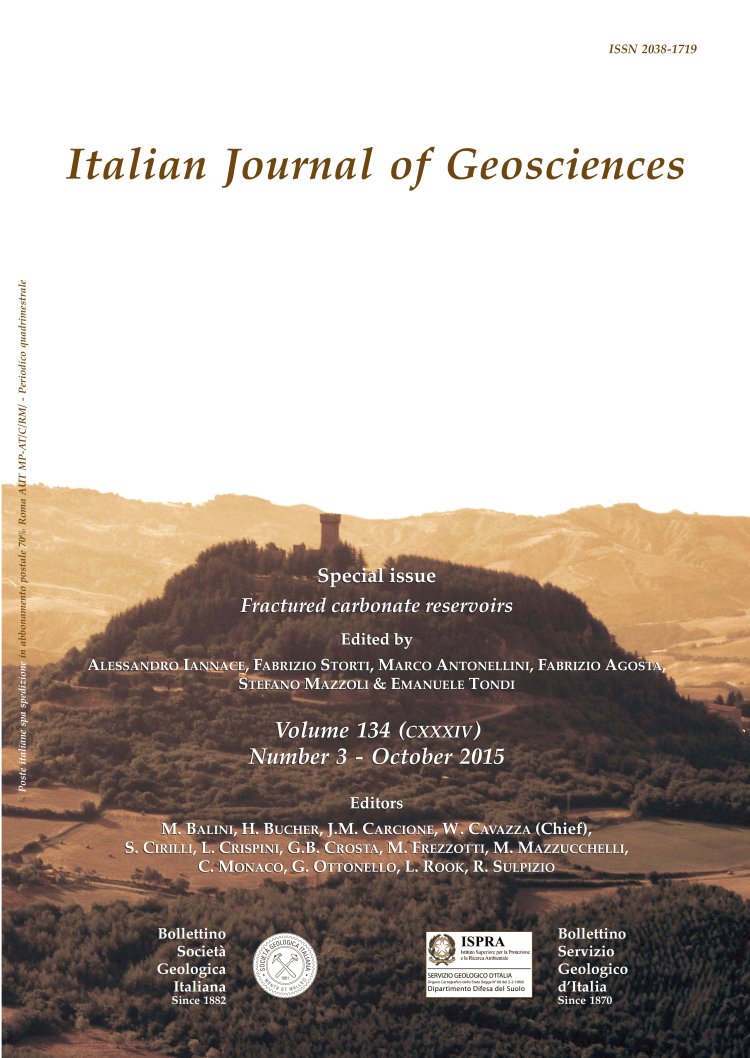
Bedding-parallel stylolites in shallow-water limestone successions of the Apulian Carbonate Platform (central-southern Italy)
Andrea Rustichelli (1), Emanuele Tondi (1), Irina Korneva (1), Patrick Baud (2), Sergio Vinciguerra (3) (4), Fabrizio Agosta (5), Thierry Reuschlé (2) & Jean-Michel Janiseck (6)
(1) Scuola di Scienze e Tecnologie, Sezione Geologia, Università di Camerino. Corresponding author e-mail: andrea.rustichelli@unicam.it; tel: +39 0737 402619; fax: +39 0737 402644.
(2) Laboratoire de Géophysique Expérimentale, EOST Strasbourg, Université de Strasbourg/CNRS UMR 7516.
(3) Dipartimento di Scienze della Terra, Università di Torino.
(4) Department of Geology, University of Leicester.
(5) Dipartimento di Scienze, Università della Basilicata.
(6) Total E&P Italia.
Volume: 134 (2015) f.3
Pages: 513-534
Abstract
Bedding-parallel stylolites typically represent the product of chemical compaction (overburden weight-induced pressure solution) experienced by carbonate successions during their burial history, when bedding is still horizontal. Due to their common occurrence in carbonate rocks, with lateral extents that can exceed 1 km, bedding-parallel stylolites are of special interest for the hydrocarbon industry because they may affect the regional fluid flow in the subsurface.
Aimed at assessing the development and distribution of bedding-parallel stylolites in shallow-water, platform limestone successions, field and laboratory studies were carried out on Cretaceous limestones originally pertaining to the Apulian Carbonate Platform realm and now exposed in three distinct Italian locations: Maiella Mountain, Gargano Promontory and Murge Plateau.
Results point to a prominent role played by the geological characteristics of limestones on development and localization of beddingparallel stylolites within shallow-water, platform limestone successions.
In particular, bedding-parallel lamination and fine rock grain size, co-occurring in stromatolitic limestones, determined there laterally more extensive and closely spaced stylolites than in the associated calcilutites and calcarenites. Large fenestral pores, which are ubiquitous in stromatolitic limestones, represent rock heterogeneities able to influence the roughness of individual stylolites.
Laboratory measurements revealed that the permeability of the studied Cretaceous limestones is very low (<10 μD). Pilot tests suggest that bedding-parallel stylolites in stromatolitic layers are not barrier to fluid flow but may represent pathways through low-permeability, platform limestone successions in the subsurface.
Aimed at assessing the development and distribution of bedding-parallel stylolites in shallow-water, platform limestone successions, field and laboratory studies were carried out on Cretaceous limestones originally pertaining to the Apulian Carbonate Platform realm and now exposed in three distinct Italian locations: Maiella Mountain, Gargano Promontory and Murge Plateau.
Results point to a prominent role played by the geological characteristics of limestones on development and localization of beddingparallel stylolites within shallow-water, platform limestone successions.
In particular, bedding-parallel lamination and fine rock grain size, co-occurring in stromatolitic limestones, determined there laterally more extensive and closely spaced stylolites than in the associated calcilutites and calcarenites. Large fenestral pores, which are ubiquitous in stromatolitic limestones, represent rock heterogeneities able to influence the roughness of individual stylolites.
Laboratory measurements revealed that the permeability of the studied Cretaceous limestones is very low (<10 μD). Pilot tests suggest that bedding-parallel stylolites in stromatolitic layers are not barrier to fluid flow but may represent pathways through low-permeability, platform limestone successions in the subsurface.
Keywords
Get Full Text